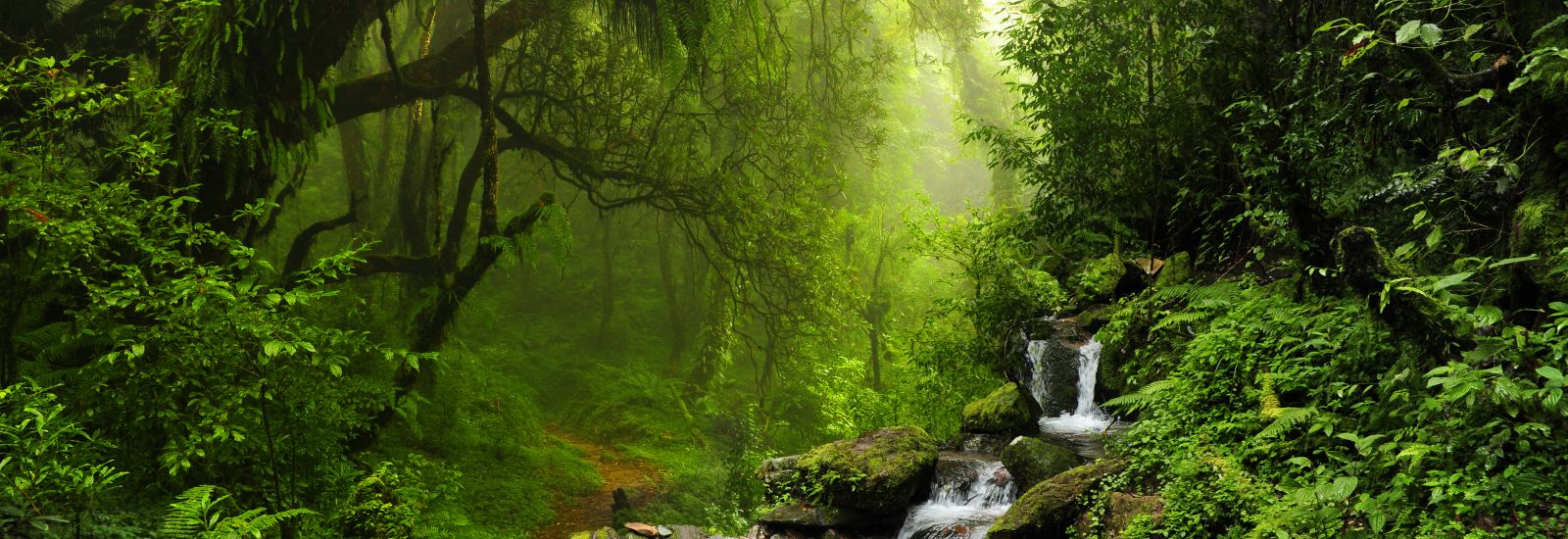
Yadvinder Malhi
My next meeting is with Yadvinder Malhi, a Professor of Ecosystem Science or – as I’ve been promised – an academic who knows lots about rainforests. I’ve come to the Environmental Change Institute in the School of Geography and the Environment, down the road from the Natural History Museum.
Talking to him in person, you quickly realise that Malhi is driven by his belief in the fundamental importance of rainforests to Earth. I ask him: given that you originally trained as a physicist, what first seized your imagination about Ecosystem Science?
'I went to the Amazon on a very technical research project to measure carbon dioxide emissions. But I found myself bewitched and seduced by everything about the rainforest. I was working in a city in the Brazilian rainforest, Manaus, and I had this map on my office wall of all of Amazonia. Manaus was just a dot in the centre of this map, and for virtually 1,000 miles in every direction there was nothing but blank green. It gave me a huge sense of awe and humility, a sense of a world in which humanity was still tiny compared to the vast forces of nature, where there was still so much to discover and learn. My equipment ended up taking three months to clear customs, and in those three months I had little else to do but teach myself tropical ecology in the library of the Amazon research institute, and Portuguese in the bars of Manaus. So that potential crisis became a life-changing moment. I learnt about the basic processes of rainforests and how they work, how many dimensions there are to the complexity of rainforests, how trees grow and how they interact with animals and the atmosphere.
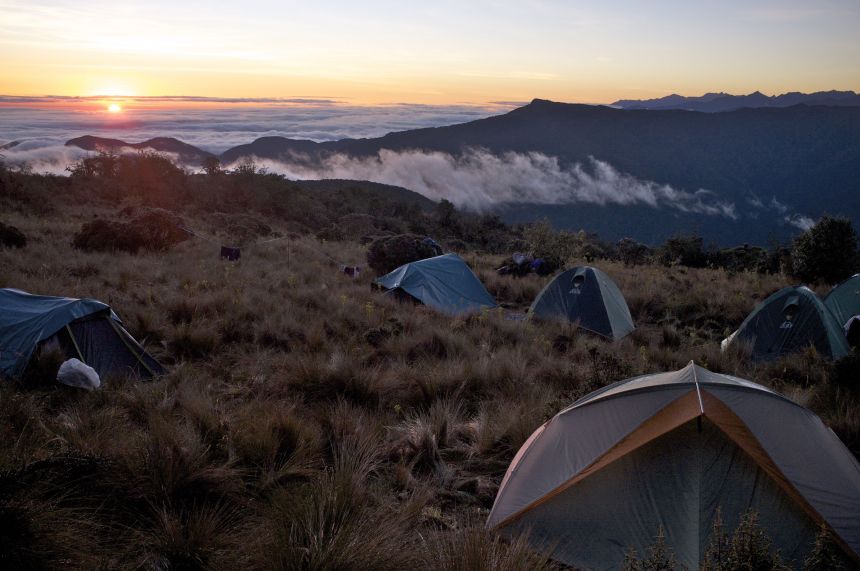 The tents at sunrise are 3500 m up in the Peruvian Andes, looking out over the Amazon Basin
The tents at sunrise are 3500 m up in the Peruvian Andes, looking out over the Amazon BasinPhoto credit: Topher Bentely
'My work focused on the lowland Amazon forests of Brazil for the first few years. Then a few years later we started looking westward at Peru. I went up the slopes of the Andes to set up a "vertical laboratory" – a transect of research sites we’ve set up over 3,500 metres in elevation on the eastern slopes of the Andes mountains, looking out over the Amazon rainforest. This natural laboratory helps us to explore and understand the impacts of warming temperatures: for example, we can move soils or plants up and down the slopes to warm them or cool them and see their responses to a change of temperature, or we can study how species are migrating in response to climate change. The Andes–Amazon transect is a unique laboratory to study these ideas as well as a mind-blowingly beautiful place to work. While working here over the past decade we came up with a methodology of how we should measure forests and how they respond to climate change.
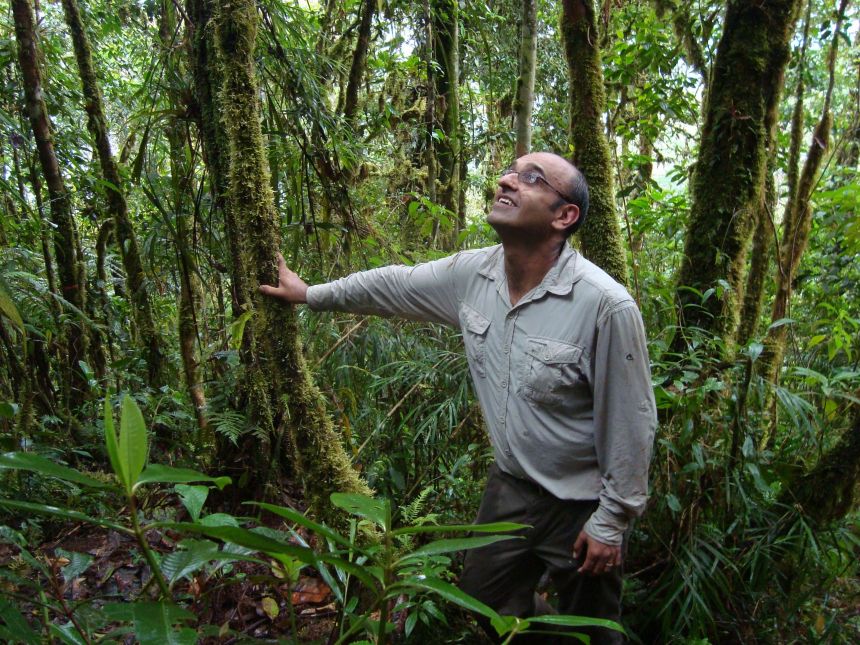 Professor Malhi in a Peruvian cloudforest
Professor Malhi in a Peruvian cloudforest'In all our sites, but particularly in Peru, we worked really closely with teams of local researchers and students. The work we are doing just wouldn’t be possible without the strong local support. And these students are just so tough, so hard working; we are usually left behind gasping for oxygen in the thin mountain air as they sprint up the mountains ahead of us.
'Looking over the horizon in the vastly underexplored realm of the tropical rainforests, there are always new questions and opportunities. In the last few years I have wanted to spread out the new methodologies we have been developing for monitoring forests into other regions of tropical rainforest. Africa in particular has been beckoning as the least studied tropical rainforest continent. So, taking my family with me, I went on an extended sabbatical to Ghana. I began to learn about how African rainforests are similar to or different from Amazonian forests, and to build solid local collaborations in several African countries. At almost the same time we had some funding to begin working in Borneo. What all these opportunities amounted to was a chance to build a global tropical forest monitoring network, which we have named GEM (the Global Ecosystems Monitoring network). In each of these places in the GEM network we have local technicians and students who go out for a few weeks each month and do exactly the same measurements whether they are in the depths of the Congo, the Amazon or Borneo. We compare these measurements and can understand how forests are ticking over day by day, month by month, around the world.'
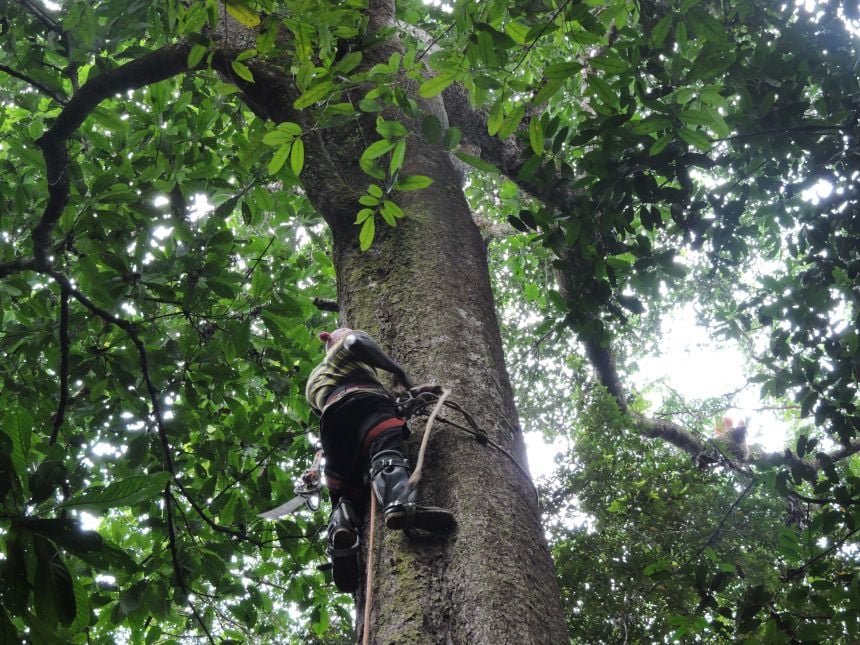 A tree climber in Ghana
A tree climber in GhanaIt’s a massive body of work scanning some of the most remote and biologically and climatically important parts of the Earth. What are your headline findings from this project?
We’ve found that the forests seem to be increasing in biomass; we think this might be a response to the carbon dioxide in the atmosphere.
'In the Amazon, we’ve found that the forests seem to be increasing in biomass; we think this might be a response to the carbon dioxide in the atmosphere. This has a modest impact on reducing carbon dioxide in the atmosphere and the rate of global warming.
'We’ve followed this monitoring system through drought events and extreme weather events to get a handle on how these forests may respond in the future to drought events. We’ve got a paper that came out in Nature in March showing how these forests were fairly resilient to droughts, because they have an internal supply of sugars. We’re trying to understand how big these reserves are – they can’t last forever.
'Now the next challenge was: how do we coordinate these studies more coherently? They’ve all been funded by different grants, but a concentrated effort is needed to build the central infrastructure of this network. Two years ago I was awarded a European Research Council Advanced Investigator Award, which has allowed me to build a centralised network, with a common database and analysis programmes that will eventually be open access, detailed studies of the biodiversity and function of the trees in each of these sites, and a webpage as a portal.
'Part of this is experimental; we've got all these researchers all over the world and we’re trying to build a community out of them, so the GEM webpage acts almost as a scientific social network. We have examples of a student in Peru asking a question about field methods, and someone in Borneo answering. We had a question from a student in Africa asking about what others do with elephants – they had a real problem with elephants destroying their equipment. Someone in India had some suggestions for more elephant-proof equipment design.
It’s clear that you're interested in creating systems that are replicable and that can make a lasting impact in your research area. I want to know where this is all heading – what do you see as the ideal ultimate legacy of your work?
'I can see two potential legacies. One is the monitoring. Rather than being an ad hoc process, as it is now, I would hope to leave a legacy of long-term ecological monitoring across tropical rainforests that can last for decades or even centuries. That monitoring is invaluable because with climate change we'll find surprises with the system: some ecosystems are more or less resilient than we expect them to be. These monitoring plots are our canaries in the climate change coal mine. Unless we really monitor what’s going on the ground, we won’t get the early warnings of potential dangers, and how we can avoid or ameliorate them. By tracking these systems over decades, we will see important insights into how these systems are responding to climate change.
'The other legacy I’d like to see is an investment in the capacity in training and research in these regions – leading to these people rising to influence within academia, NGOs and government in their respective countries, and being local and influential voices for science and conservation. That’s the most likely way we can get long-term and sustainable management of tropical forest regions, when we get voices within the country who understand the issues and campaign for them.
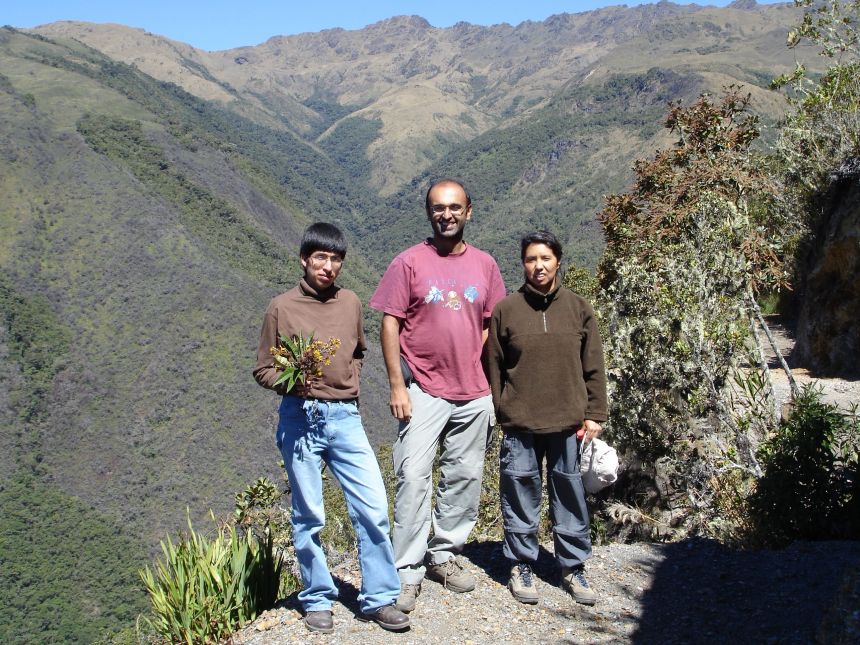 Professor Malhi in the Peru transect
Professor Malhi in the Peru transectHow significant is your work to conserve the tropical forests – what are our best- and worst-case scenarios for climate change within tropical forests in 100 years' time?
'In terms of tropical forests, my work isn’t just about climate change; I’m interested in all the facets of pressure and change in the forests. If you want to understand where tropical forests are heading you can’t isolate climate change from deforestation, logging and hunting. I'd say the best case scenario is where there is still ongoing social and economic development in the tropics, and there is an improvement in people's livelihood, but it's done in a way that maintains large areas of intact and functional forests which provide a home to what is over half of the Earth’s biodiversity. I see there are some countries where, if we can get the governance in place and link it into the science, the tropical forests have a decent chance of surviving. So if you asked me about the future of the Amazon, I’d say there are challenges there, but I’d be optimistic. Climate change is a threat, but if it's not hugely disturbed, or disturbed in a careful way, the Amazon can be resilient to the changes it faces.
'Currently the scenario leads to far more pessimism in Asia, where there has been relatively far more extensive deforestation. I think the most optimistic scenario here is to see them transitioning to a similar scenario, where there are limits to the deforestation and degradation that occurs, and we ensure critical parts of the ecosystem are left intact.
'The Central African rainforest is relatively unknown. It’s not very deforested at the moment, but for the wrong reasons: civil conflict, insecurity and lack of development. It could well be opened up and exploited in a very uncontrolled way in the near future. The challenge is to get this conservation and governance in place before this tidal wave of economic pressures wash over the Congo Basin.
Supposing these things happened across the tropical forests in the worst-case scenario, what would the effect of that be on the livelihood of most of us in the west?
'The tropical forests hold a substantial amount of biomass carbon, so the direct carbon effect on our climate is significant. But there are a lot of other aspects of tropical forest influence on climate that we understand far less about. The tropical regions are the engines of the planetary circulation. If we removed vast areas of rainforest and converted them into cattle ranches or soya bean fields, we’d probably change the water cycling of entire plant. The modelling studies that look at that suggest you’d end up affecting rainfall patterns as far away as Europe, Siberia and North America. It’s really hard to pin down exactly what would happen: it’s very hard to say with certainty if you removed forest in Eastern Amazonia then rainfall in Britain would change. But you can say that there would be consequences on a global scale.
'There are probably other aspects that we know even less about: tropical forests are important as generators of cloud, and cloud reflects sunshine into space, and in the tropics clouds act as a cooling system. We don’t really understand what the consequences would be, but it is fair to say there would be consequences.'
Over half of the richness of life on earth is in the tropics; it would be ethically wrong for that to disappear.
'The other argument I always comes back to is that we don’t have to think about it in terms of what the tropical forests do for us. The forests have value in themselves as the most spectacular celebration of what this planet is about – what it means to be on this planet. Over half of the richness of life on earth is in the tropics; it would be ethically wrong for that to disappear. The forests could largely degrade in our lifetimes, but we have a responsibility to the planet we emerged on and live on as much as we do to humans. And so to me that basic ethical argument is the most important.'
It’s a fantastic point to end on; I’m interested in what local students and residents can make of the natural environment. Can you give me the lowdown on Wytham Woods?
'We do a lot of work in Wytham. It’s interesting in itself as an object of research and partially for me it’s therapy. When I can't get to a tropical rainforest, I can poke around in there for a bit.
It’s a great place to try out ideas of what we’re trying to measure, but also to try out people. We have students do projects in Wytham, see the ones that particularly have a knack for working the field, and then encourage them to apply these ideas to more adventurous sites, further away.
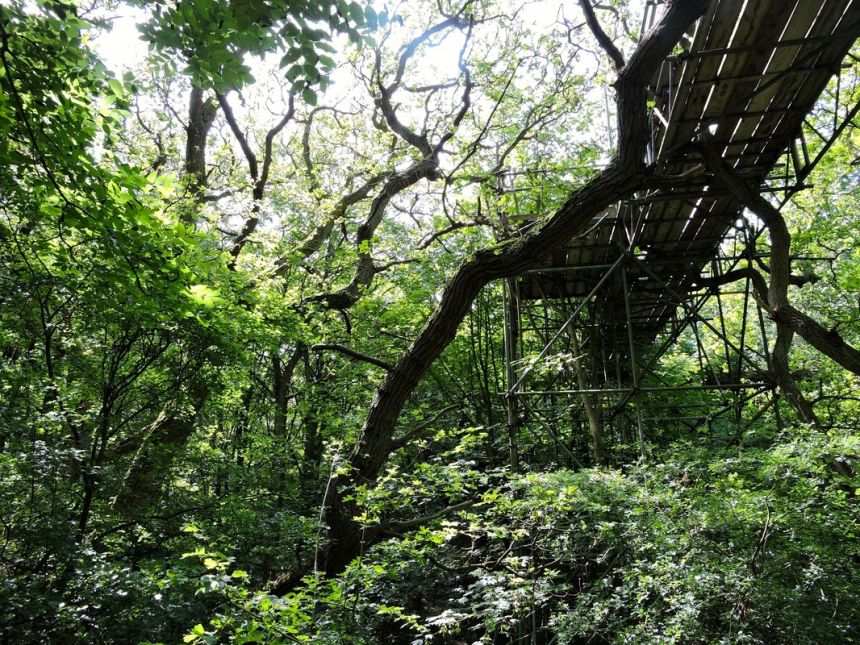 Wytham canopy
Wytham canopyFinally, I'd like to know what gives you most job satisfaction?
'On a very personal level – it’s just going out, sitting quietly, and being surrounded by rainforest. I’m always happiest in a rainforest. When I’m there I realise this is why I do what I do. Everything else seems trivial. On a broader level I love interacting with the people I work with – whether that’s my team here or the huge networks of collaborators and researchers in the wider tropical forest community. I think the tropical forest research does attract people who are slightly crazy, slightly maverick and also very good people to be with. A good test of whether you want to hire someone is whether you’d be willing to share a tent with them in a rainforest for a week. We tend to be a very social group of people and enjoy each other's company.'
Read more about Yadvinder’s adventures in the field on his blog at: yadvindermalhi.org/blog.
To see a map of where his teams are working, have a look at gem.tropicalforests.ox.ac.uk – these are the people in the scientific social network and their posts, feeds and photos.
The Oxford Centre for Tropical Forests is a local network to bring together people from all walks of life in Oxford: academics, local businesses and government but also interested members of the public.
Yadvinder Malhi is a Jackson Senior Research Fellow at Oriel College, Oxford.
